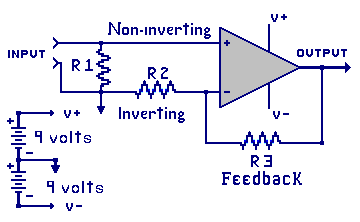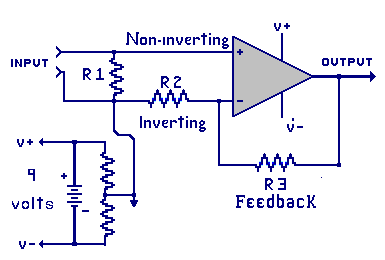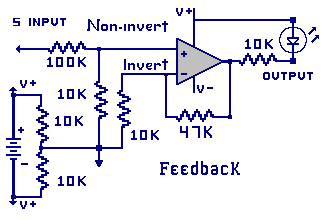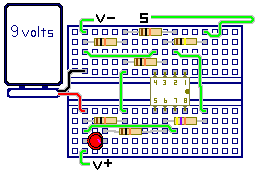This is Book 2
Chapter 7 - AC and Hertz
Chapter 8 - Magnetism
Chapter 8.2 - Inductors
Chapter 9 - Power Supply
Chapter 9.2 - Power Supply Filters
Chapter 10 - IC's and Amplifier
Chapter 10.2 - OP AMP Feedback and Unity Gain
Chapter 10.3 - OP AMP Non-Inverting
Chapter 10.4 - OP AMP Inverting
Chapter 11 - 555 Timer
Chapter 11.2 - Counters
Chapter 12 - Logic
Back To The Guide
Take Me Home
Non-inverting amplifier
Op Amp - Dual-Rail Supply:
This configuration is a Non-inverting Operational Amplifier using a
dual-rail supply consists of two 9 volt batteries. The supply provides
+9V (one rail), with respect to the circuit common(ground) as well as a
-9V (another rail).
The resistors value for R1 and R2 are 10K and
the value for R3 is 100K.
Notice that there is a voltage divider
circuit build around the inverter pin. One end of the divider is where
R2 is tied to circuit common. The center of the divider is where the
other end of R2 plus the inverter pin of the Op Amp and one end of R3
are all joined together. The other end of R3 is tied to the Op Amp output
pin which completes the voltage divider circuit. One of the INPUT ports
is tied to the circuit common point. The second INPUT port is tied to
the non-inverting input. To keep this input from floating and picking up
stray signals R1 is used. The value is large enough as to not impact the
input signal from moving the input voltage around. OK, Here is how this works.
Positive input voltage:
1) The output is sitting at O volts due to the two input voltages being
at 0 volts. No voltage drop is across R1, R2 or R3. The Op Amp is at State-2.
2) Now by increasing the input port voltage to +0.1V, this will cause
non-inverter pin to signal the op amp to jump to State-3. The output
starts to increase. The R3 starts applying that feedback voltage to the
inverting pin until that pin also increased to +0.1 volts at which point
the op amp switched back to state-2, with the output voltage at whatever
level is required to hold the inputs at the same voltage level
3) Question: With both inputs +0.1V, what is the output voltage? Using
Ohms law and the basic R2, R3 voltage divider, we can calculate the
output voltage of the amplifier.
There is 0.1 volts across R2 of 10,000 ohms.
R2 current = 0.1/10000 or 0.01mA
Recall that the current in a series circuit is the same everywhere within the circuit.
There is the same 0.01mA through R3 of 100,000 Ohms.
R3 voltage = 0.00001 X 100000 or 1V.
Total output voltage = 0.1V(R2) + 1.0V(R3) = 1.1V
4) The voltage gain of the amplifier.
The gain formula is Gain = 1 + R3/R2.
GAIN = 1 + 100,000/10,000 or a gain of 11.
5) Yes, the output voltage change = 11 times the input change.
Negative input voltage:
6) Now by decreasing the input port voltage to -0.1V, the non-inverter
pin will signal the op amp to jump to State-1. The output starts falling.
The R3 starts applying that feedback voltage to the inverting pin until
that pin also decreases to -0.1 volts at which point the op amp switched
back to stage-2.
7) Find the new output voltage the same way.
There is still a voltage drop across R2 of 0.1 V, however the current
is flowing is the other direction, so -0.1V.
The divider current is the same at 0.01 mA in the circuit.
Output voltage is -0.1V(R2) + -1.0V(R3) = -1.1V
The gain is the same 11
Using Smooth Transitions:
Lets look again at this example and replace the input voltage steps
with a smooth SINE WAVE moving between -0.1V and +0.1 volts. I have
graphed one cycle here. This is called a 0.2 volts peak-to-peak
input signal. Because the speed of the Op Amp's reaction to its
changing inputs is sufficiently fast, the output will also be smooth
with a 2.2 volt peak-to-peak output swing.
At this point in our study, we see that by providing the Op Amp with
either a DC or an AC input voltage, we can, in effect, get a larger
DC or AC output voltage. Thereby observing how the basic amplifier
circuitry works as a voltage amplifier.
Changing Circuit Gain:
We saw in the example above that the circuit has a gain of 11. Now
we will look at making changes to the feedback circuitry and thus
changing the Op Amp's gain.
Changing R3:
What is the effect, if R3, the feedback resistor is changed form 100k ohms
to 200k ohms. R1 and R2 remain the same and we set the input port to +0.1V
The R2 voltage drop still needs to be 0.1v so the current through
R2 will still be 0.01mA.
Voltage across R3 is E=(IxR) = 0.00001 X 200,000 or 2V.
Total output voltage = 0.1V(R2) + 2.0V(R3) = 2.1V
The new gain is GAIN = 1 + 200,000/10,000 or a gain of 21.
Changing R2:
What is the effect if we now leave R3 at 200K, and change R2 to 15K.
This will change both the current through the voltage divider and the
gain of the amplifier.
R2 voltage drop of 0.1V and 15K has a new current of 0.00667mA.
Using that current with 200K Ohm gives 1.33V across R3
So output voltage is 1.43 volts
The GAIN = 1 + 200,000/15,000 or 14.3.
A couple of other thoughts.
When the input signal (sine wave) voltage is very small, placing two
op amps in series, each with a gain of 11 gives a total circuit gain
of 11 X 11 or 121. Three series op amps with this gain is 11 X 11 X 11
or a gain of 1331. Op amps are great for boosting very small signals
but the available output voltage range is limited so additional
components may be needed if a very large output voltage is needed.
General purpose Op Amps are also not designed to supply large currents,
so here again, if large currents are needed at the output, additional
components may be needed.
Op Amp - Single Rail Supply:
This configuration is a Non-inverting Opertional Amplifier using a
single rail supply consisting of one 9 volt battery. When using a
single rail supply, to replace the previous dual rail supply, there
is a need to add another voltage divider circuit to provide the
reference point for circuit common (ground) as supply mid-point.
As drawn this circuit is using only 9 volts, which replaced the
18 volts of the last example. With half the available supply
voltage the Op Amp is limited to half the output voltage swing.
Note that the supply is only 9 Volts, but could be any reasonable
voltage depending on the specifications of the Op Amp you choose.
The higher the potential of the power supply voltage, a higher
output voltage swing and a higher gain can be realized.
In simple terms, a 9 volt supply will support about a 6 v
peak-to-peak output swing, while a 20 volt supply will support
about a 17 v output swing.
There are some other basic Op Amp complications to address, but
at this time we will not introduce additional complications to
the circuitry.
Experimenting with Op Amp and LED
Go to the work bench.
Review the Resistor Color Code chart and wire up the kit as described.
Perform the lab, and record your results.
In this experiment we will bring lots of our learning to this point
into play. The goal of this experiment is to control the LED with the
Op Amp. In this experiment we will be using a 741 Op Amp IC, powered
with a single-rail power supply (9V battery).
Working in conjunction with the battery, there are 2 10K resistors in
a voltage divider design to provide the centering of the circuit common
mid way between the V+ and V- terminals of the battery. A third 10K
resistor works in conjunction with a 47K resistor, forming the feedback
and voltage divider circuitry for the inverting input. A forth 10K
resistor working in conjunction with a 100K input resistor, forming
another voltage divider as part of the non-inverting input circuitry.
The fifth 10k resistor is a current limiter in series with the LED
output circuitry.
Parts List:
1 9-volt battery
1 Battery power clip
5 10K ohm resistor
1 47K Ohm resistor
1 100K ohm resistor
1 741 Op Amp
1 red light emitting diode
1 experimenters board
wire as needed
How this works:
The battery provides power to the circuit and to the voltage divider. The
voltage divider is the circuit common ground mid-point of the battery voltage.
This voltage is tied to the Op Amp inputs setting the output at about 4.5 volts
below V+. The LED is tied to the V+ and through a 10K resistors to the Op Amp
output, so there is so some current flowing through the output circuitry causing
the LED to give some light.
Light Out: Taking the loose end of the S input wire, touch it
to the V+, which is 4.5 volts higher then the circuit common, current flows
through the non-inverting voltage divider (100K and 10K) taking that IC input to
about 4.9V. This causes the op amp, with a gain of 5.7, to raise the output
voltage until the feedback voltage can bring the inverting input to the same
approximate 4.9V. This gain of 5.7 times the change in input voltage ( 0.4 volts)
raises the output another 2.3V. With the Op. Amp output now around 6.8 V will
cause the LED to be starved for current and it goes out. Recall that the LED
converts current into photon energy. No current, no photons.
Light Brighter: Taking the loose end of the S input wire,
touch it to the V- voltage and the reverse process happens, moving the output to
about 2.3V lower then in originally was. This is about 2.2 volts output of the
Op Amp. The LED is now brightly shining because of the larger current flowing
through it. Lots of current, lots of photons.
« Previous Chapter Next Chapter »
Email us: info@shoeboxkits.com





